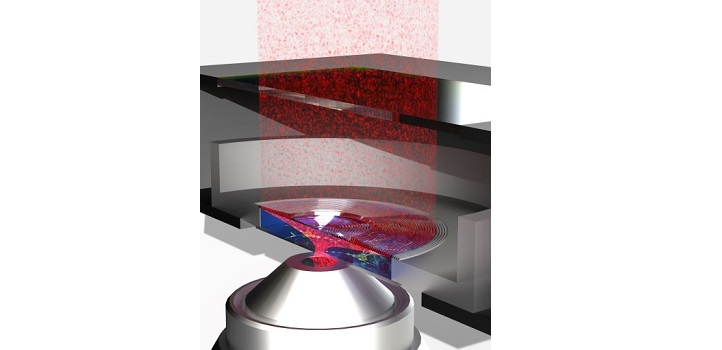Oct 6 2020
An optical device that looks like a tiny lighthouse lens can make it simpler to look closely into Petri dishes and detect molecular-level details of biological systems, such as cancer cell growth. The new cost-effective lens has been developed by KAUST.
 A 3D-printed lens developed at KAUST uses optical features inspired by lighthouse beams to collect laser signals for bioimaging. Image Credit: © 2020 Andrea Bertoncini.
A 3D-printed lens developed at KAUST uses optical features inspired by lighthouse beams to collect laser signals for bioimaging. Image Credit: © 2020 Andrea Bertoncini.
A number of bioimaging methods necessitate the addition of fluorescent dyes to particular cell targets. But a newly developed technique called stimulated Raman scattering (SRS) microscopy can eliminate laborious labeling steps by using laser pulses to gather molecular vibrational signals from biological specimens.
The capacity of SRS microscopes to create high-resolution, noninvasive images at real-time speeds has encouraged researchers to use them also for in vivo disease diagnostic studies.
However, one disadvantage of SRS microscopes, is that the detection system is influenced by a background signal, called cross-phase modulation, produced by the strong interactions between laser pulses and the specimens.
This background signal is ubiquitous and reduces the contrast during microscopic observation of complex samples, such as live cells. It also makes it difficult to identify target molecules.
Carlo Liberale, Study Lead, KAUST
To eliminate the impacts of cross-phase modulation, most SRS microscopes have to use large glass objectives that can collect wide angles of light. But such lenses are virtually impossible to fix into the stage-top incubators used to grow live cells for bioimaging.
Andrea Bertoncini, a researcher in Liberale’s group, directed the work to develop an ultrathin SRS lens with the help of laser-based three-dimensional (3D) printing. Using the slim design of lighthouse lenses as the clue, the KAUST researchers printed miniature lens-like and mirror-like features into a transparent polymer measuring just a fraction of a millimeter in thickness.
This type of lens design is a very efficient way to collect and redirect light coming from wide-angle sources right to our laser detector. And since it's so thin, it easily fits into the closed chambers of an incubator.
Andrea Bertoncini, Study Researcher, KAUST
When the calibration trials established that the new lens could eliminate the cross-phase modulation background, the team focused their efforts on human cancer cells cultured in a traditional Petri dish.
These experiments showed that the lens could image the inner components of the cell with a resolution like that of conventional SRS microscopes but in a considerably more suitable and low-cost setup.
The objectives we normally use to collect SRS microscope signals cost a few thousand dollars. Now we have a lens with similar benefits that we can produce for less than a tenth of that price.
Andrea Bertoncini, Study Researcher, KAUST
Microscope lens inspired by lighthouse
KAUST researchers have developed an ultrathin lens that fits into the stage-top incubators that are used to grow live cells for bioimaging. Video Credit: © 2020 KAUST.
Journal Reference:
Bertoncini, A., et al. (2020) 3D-printed high-NA catadioptric thin lens for suppression of XPM background in Stimulated Raman Scattering microscopy. Journal of Biophotonics. doi.org/10.1002/jbio.202000219.
Source: https://kaust.edu.sa/en